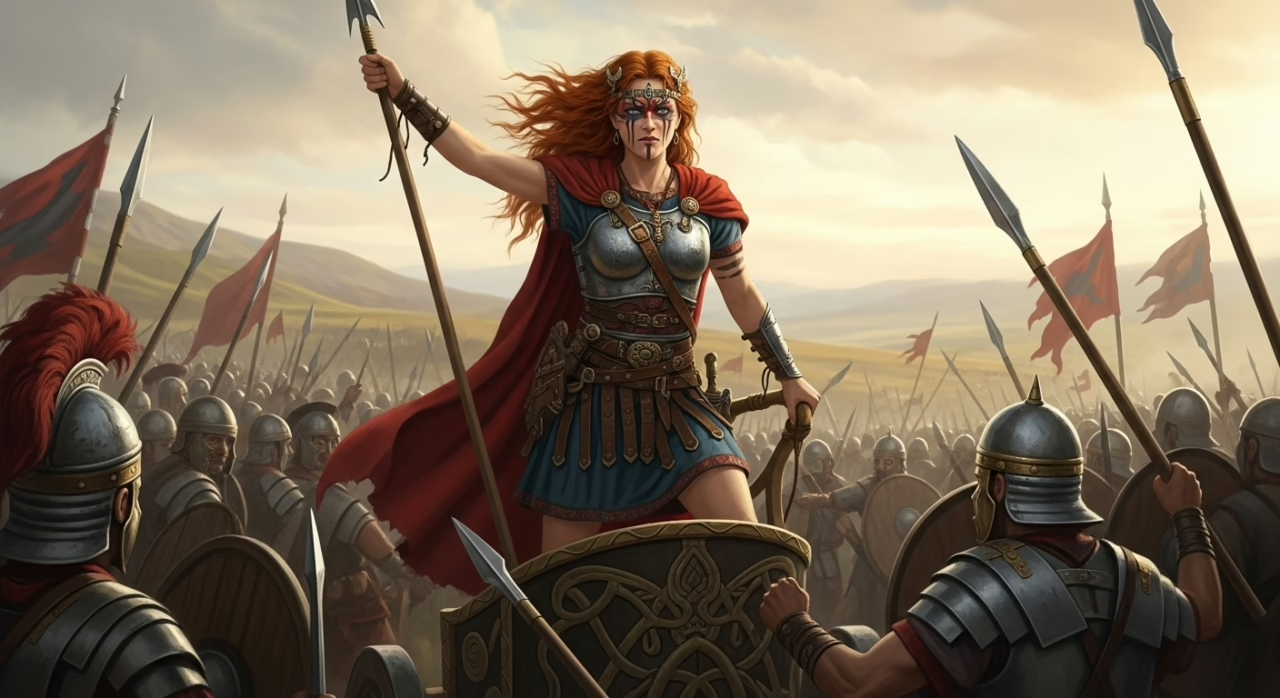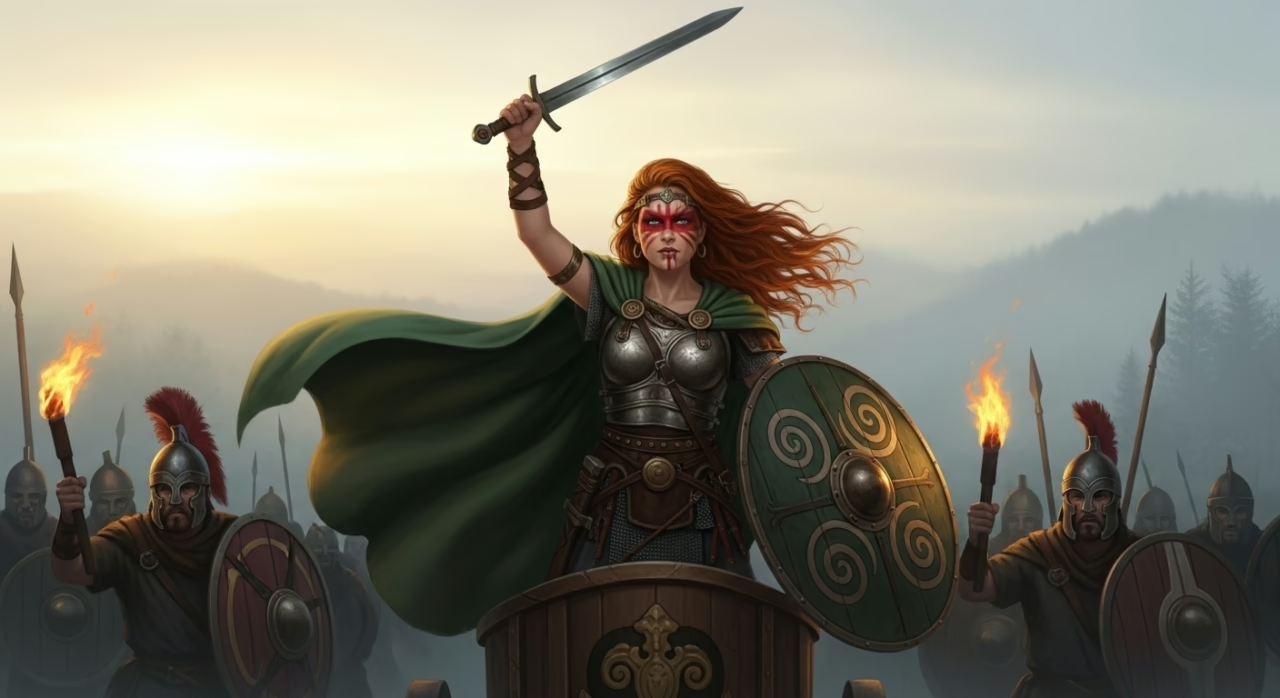Boudica: Warrior Queen of Britain

The Life and Legacy of Warrior Queen Boudica – Boudica’s insurrection against Roman dominion stands as an exemplar of indigenous resistance, crystallizing the tensions between imperial power and tribal sovereignty.
The widow-queen, subjected to public flogging and the violation of her daughters, transformed personal indignity into revolutionary fervor.
Her campaign obliterated Colchester, London, and St. Albans—settlements that represented Rome’s encroaching influence on Celtic Britain.
Scholars debate her tactical acumen, yet none question her catalytic role in challenging the empire’s presumed invincibility. What motivated her followers to risk certain retaliation?
TL;DR
Hide- Boudica led the Iceni tribe in a massive rebellion against Roman occupation after personal abuse and tribal exploitation.
- She successfully sacked three major Roman settlements: Camulodunum, Londinium, and Verulamium, killing an estimated 70,000 Romans.
- Her rebellion ended at the Battle of Watling Street where superior Roman tactics defeated her numerically larger Celtic forces.
- Archaeological evidence confirms the destruction layer from Boudica's revolt through burnt remains and buried treasures.
- Boudica remains a powerful symbol of resistance and national identity in British culture and historical memory.
Who Was Boudica?
Boudica, the formidable queen of the Iceni tribe in first-century Britain, emerged from relative obscurity to become the embodiment of resistance against Roman imperial expansion.
The Iceni, a prosperous Celtic tribe inhabiting what is now Norfolk in eastern England, maintained an initially cooperative relationship with Rome until a succession crisis following King Prasutagus’s death precipitated catastrophic conflict.
Archaeological evidence from Iceni territories, including distinctive gold torcs and ceremonial artifacts, illuminates the sophisticated cultural milieu that shaped Boudica before her transformation into the commander of Britain’s most significant indigenous rebellion against Roman authority.
Life and Background of the Iceni Queen
Boudica, whose early life remains largely undocumented in historical records, emerged into prominence through her marriage to Prasutagus, King of the Iceni tribe in eastern Britain during the Roman occupation.
As queen consort, she assumed significant responsibilities in tribal governance, possibly managing domestic affairs while Prasutagus negotiated the tribe’s semi-independent status with Roman authorities.
Archaeological evidence and Roman accounts suggest that beyond her political role, Boudica was mother to two daughters whose names are unrecorded but whose fates would become inextricably linked with her legendary rebellion against Rome.
Early life and marriage to King Prasutagus
Shrouded in the mists of pre-Roman Britain, the early life of the formidable Iceni queen remains frustratingly elusive to historians, with scarce primary sources offering only fragmentary glimpses into her formative years.
Boudica’s upbringing likely reflected traditional Iceni customs, potentially from royal lineage. Her marital alliance with King Prasutagus consolidated power through:
- Strategic tribal positioning against Roman encroachment
- Unification of bloodlines within noble Iceni families
- Preservation of indigenous cultural traditions amid imperial pressure
Role as queen and mother
As her marriage to Prasutagus solidified her political standing, the royal duties of the Iceni queen extended far beyond ceremonial functions into domains of genuine influence and authority.
Boudica balanced queenly responsibilities with maternal influence, raising two daughters while mastering diplomatic leadership styles.
The cultural expectations of her society, which typically positioned women behind male counterparts, were transcended through her exceptional acumen in managing domestic affairs and tribal governance.
Iceni Tribe and Their Struggle with Rome
The Iceni, a prosperous Celtic tribe inhabiting what is now Norfolk in eastern Britain, maintained a complex social hierarchy characterized by sophisticated metalwork and agricultural practices prior to Roman incursion.
Their initial status as a client kingdom under Emperor Claudius granted them nominal autonomy while requiring tribute—an arrangement that deteriorated rapidly after King Prasutagus‘s death when Roman procurators seized Iceni lands and wealth.
This calculated subjugation, coupled with the brutal flogging of Boudica and assault of her daughters, transformed long-simmering resentment into explosive resistance against Roman imperial authority.
Iceni society and culture
Iron Age Britain gave rise to the Iceni tribe, a Celtic people whose sophisticated society flourished in what is now modern Norfolk and Suffolk during the first century BCE.
Their social hierarchy reflected Iceni customs of tribal governance balanced between noble families and warrior classes.
- Celtic spirituality permeated daily life through ritual observances and sacred groves
- Local trade networks established regional prominence in metalworking and agriculture
- Independent political structure fiercely maintained tribal autonomy before Roman incursion
Causes of conflict with Roman rule
While Iceni society maintained its cultural distinctiveness for generations, relations with Rome deteriorated rapidly after Emperor Claudius launched his conquest of Britain in 43 CE.
The Iceni initially negotiated client-kingdom status, preserving nominal tribal autonomy amidst Roman expansion.
However, systematic economic exploitation, aggressive cultural assimilation policies, and escalating military oppression—particularly centurions’ confiscation of ancestral lands and treasures—transformed grudging accommodation into open hostility.
The Spark of Rebellion
The catalytic moment for Boudica’s rebellion emerged from the Romans’ flagrant disregard for Celtic autonomy, culminating in her public flogging and the assault of her daughters after her husband’s death.
Roman officials, dismissing the inheritance rights stipulated in King Prasutagus’s will, seized Iceni lands and subjected the royal family to unconscionable humiliation—an act that transcended mere political subjugation to become personal violation.
This profound indignity resonated across tribal boundaries, enabling Boudica to transform isolated tribal grievances into a unified Celtic resistance against Roman imperial domination.
Injustice and Humiliation by Romans
Following King Prasutagus’s death, Roman officials ignored his will that bequeathed half his kingdom to Emperor Nero and half to his daughters, instead seizing Iceni lands as if conquered territory.
Roman procurators subjected Queen Boudica to flogging in public view while forcing her to witness the assault of her daughters, acts that violated not only Icenic royal dignity but also fundamental tribal customs regarding women’s status.
These calculated humiliations, recorded by the historian Tacitus as “kingdom pillaged by centurions, house plundered by slaves,” transformed a potentially manageable succession dispute into the catalyst for Britain’s most significant indigenous rebellion against Roman rule.
Betrayal after the death of Prasutagus
When King Prasutagus of the Iceni died in 60 CE, he bequeathed his kingdom jointly to the Roman Emperor Nero and his two daughters, a tactical compromise intended to preserve his family’s status and his tribe’s semi-autonomous position within the Empire.
Rome’s betrayal manifested swiftly through:
- Seizure of Iceni lands, revealing imperialist power struggles
- Flogging of Boudica, a calculated public humiliation
- Violation of her daughters, demonstrating Rome’s contemptuous tribal dynamics
Brutal treatment of Boudica and her family
Rome’s brutality against Boudica and her family represents one of history’s most egregious catalysts for indigenous rebellion, searing itself into both Roman chronicles and Celtic oral tradition.
Following Prasutagus’s death, Roman officials publicly flogged Boudica and raped her daughters—historical injustices that transcended mere subjugation.
This family trauma, rather than crushing Boudica’s resilience, ignited a resistance whose cultural ramifications would expose the savage face of Roman cruelty.
Rallying the Celtic Tribes
Boudica’s exceptional oratorical prowess enabled her to unite various Celtic tribes that had previously maintained uneasy relationships with one another, forging them into a formidable coalition against Roman occupation.
Drawing upon shared grievances and the perceived desecration of ancestral lands, she cultivated a pan-tribal identity that temporarily superseded long-standing inter-tribal rivalries.
Her compelling narrative of resistance, coupled with her status as a violated queen, transformed disparate tribal resentments into a coordinated military response that would challenge the seemingly invincible Roman authority in Britannia.
Uniting the tribes against a common enemy
The strategic unification of Britain’s feuding Celtic tribes under Boudica’s leadership represents one of the most remarkable diplomatic accomplishments in Iron Age Britain.
Through tribal alliances and cultural solidarity, she forged a united front against Roman occupation.
Her leadership strategies included:
- Appealing to common cause through shared grievances
- Emphasizing indigenous traditions over foreign domination
- Cultivating inter-tribal solidarity despite historical rivalries
Boudica’s inspiring leadership
Beyond mere tribal unification, what truly ignited the fire of Celtic resistance against Rome was an extraordinary quality of charismatic battlefield magnetism—a quality embodied fully in the Iceni queen who would become Britain’s most legendary resistance figure.
Boudica’s emotional resilience transformed personal tragedy into collective purpose, her leadership traits combining strategic decisions with cultural significance that resonated deeply among Celtic warriors seeking liberation from imperial dominance.
Boudica’s Legendary Revolt
Boudica’s vengeful campaign swept catastrophically through the Roman settlements of Britannia, beginning with the obliteration of Camulodunum, where the Temple of Claudius—a symbol of imperial subjugation—was reduced to smoldering ruins.
Her forces, emboldened by initial triumph, advanced to Londinium and Verulamium, where contemporary accounts describe conflagrations of such intensity that archaeological excavations still uncover layers of red-hued debris, evidence of the inferno that consumed these prosperous Roman trading centers.
The systematic destruction of these three prominent urban centers not only demonstrated Boudica’s tactical acumen but also embodied her strategic objective: to excise Roman presence from Iceni territory and beyond, a campaign that Tacitus estimated claimed some 70,000 Roman lives.
Attack on Camulodunum (Colchester)
Boudica’s rebellion achieved its first significant triumph at Camulodunum, the former Trinovantian capital transformed into a Roman colony populated by veteran soldiers.
The insurgents systematically dismantled this symbol of Roman authority, focusing particular wrath on the Temple of Claudius, which represented both religious subjugation and the financial burden imposed through its maintenance costs.
Archaeological evidence from this period reveals a distinctive destruction layer containing melted glass, collapsed structures, and human remains—physical evidence to the thorough nature of Boudica’s vengeance against those who had colonized Britannic lands.
First victory against Roman colonists
The Iceni army surged toward Camulodunum in 60 CE, marking the explosive beginning of Boudica’s rebellion against Roman occupation.
Her strategic brilliance, coupled with formidable tribal alliances, overwhelmed the unprepared settlement.
The Celtic resistance succeeded through:
- Exploitation of the absent Roman garrison
- Coordinated multi-tribal assault tactics
- Psychological warfare against Roman colonists
This initial victory ignited the flame of liberation across Britannia.
Destruction of the Roman temple
After securing control of the surrounding countryside, Celtic warriors descended upon the crown jewel of Roman occupation in Britannia—the Temple of Claudius.
This temple destruction represented more than military conquest; it symbolized reclamation of sacred sites and indigenous religious practices.
Battle of Londinium (London) and Verulamium (St Albans)
After sacking Camulodunum, Boudica’s forces marched towards Londinium, a thriving Roman commercial center, which they systematically razed to the ground, slaughtering inhabitants and leaving archaeological evidence of a destruction layer dated to 60-61 CE.
Contemporary accounts by Tacitus estimate that approximately 70,000 Romans and provincial allies perished across Londinium and Verulamium, where Boudica’s warriors employed similar tactics of fire and sword, though modern historians debate the accuracy of these figures.
The scale of devastation proved so profound that excavations reveal a distinct burnt horizon in both settlements, with melted glass, collapsed buildings, and scattered human remains testifying to the ferocity of the Iceni and their allies’ vengeance against Roman occupation.
Devastating strikes on Roman settlements
Launching her devastating campaign against Roman occupation, Boudica led her coalition forces toward the thriving settlement of Londinium in 60 or 61 CE, striking at the heart of Roman Britain’s commercial center.
Boudica’s strategies exemplified sophisticated military tactics:
- Targeting economic hubs to maximize impact
- Exploiting Roman defenses weakened by dispersed legions
- Leveraging Celtic alliances to overwhelm imperial forces
Historical narratives reveal her methodical dismantling of Roman authority.
Scale of destruction inflicted by Boudica’s forces
The scale of destruction Boudica’s forces released upon Roman Britain stands unparalleled in the imperial province’s history, with archaeological evidence revealing layers of distinctive red ash—now termed “Boudican destruction horizon”—that mark the fiery devastation of 60/61 CE.
Boudica’s strategy of total warfare empowered her Celtic warriors to raze Londinium and Verulamium completely, leaving lasting impact that prompted a ruthless Roman response.
The Decisive Battle Against Rome
The Battle of Watling Street marked the catastrophic culmination of Boudica’s rebellion, where despite numerical superiority, her forces succumbed to Roman tactical discipline and the strategic genius of Governor Gaius Suetonius Paulinus.
Historical accounts, primarily from Tacitus, suggest that following this defeat, Boudica chose poison over capture, though archaeological evidence remains frustratingly inconclusive regarding her ultimate fate.
The aftermath reshaped Romano-British relations fundamentally, initiating a period of punitive Roman governance that paradoxically strengthened occupation while immortalizing Boudica as an enduring symbol of indigenous resistance.
Battle of Watling Street
The Battle of Watling Street in 60 or 61 CE marked the climactic confrontation between Boudica’s coalition of British tribes and the disciplined forces of Roman governor Suetonius Paulinus.
Despite commanding a numerically superior force—perhaps 100,000 warriors against Rome’s 10,000 legionaries—Boudica found herself outmaneuvered when Paulinus selected a battlefield with a narrow frontage, negating the Britons’ numerical advantage while maximizing Roman tactical superiority.
The aftermath proved catastrophic for the British resistance: Tacitus records that while Roman casualties numbered merely in the hundreds, an estimated 80,000 Britons perished, effectively ending Boudica’s rebellion and cementing Roman control over southern Britain for centuries to come.
Boudica’s final confrontation with Suetonius Paulinus
After Rome’s devastating campaigns across Britannia, Boudica’s forces and Governor Suetonius Paulinus’s legions converged in 61 CE at what historians now identify as the Battle of Watling Street.
The final showdown revealed:
- Paulinus’s strategic decision to engage on favorable terrain
- Boudica’s leadership qualities faltered against disciplined Roman battle tactics
- The confrontation’s historical significance marked the end of organized native resistance
Tactics and outcome of the pivotal battle
While Boudica’s massive tribal army approached the Roman position with overwhelming numerical superiority, Suetonius Paulinus had meticulously arranged his forces in a defensive formation that would prove devastatingly effective against the Britons’ chaotic assault.
His tactical innovations exploited the battlefield’s narrow terrain, using disciplined military formations against the Iceni’s numerical advantage.
Paulinus’s calculating leadership style contrasted sharply with Boudica’s passionate approach—a difference that ultimately determined the battle’s tragic outcome for Britain’s freedom fighters.
Aftermath and Boudica’s Fate
The fate of Boudica after the catastrophic defeat at Watling Street remains one of ancient Britain’s enduring mysteries. Tacitus suggests she poisoned herself rather than face capture, while Cassius Dio offers no definitive account of her end.
For the Iceni and allied tribes, the aftermath proved devastating: thousands slaughtered, survivors enslaved, and tribal lands systematically ravaged by Roman forces determined to prevent future rebellions.
The failed uprising, rather than securing British independence, ironically strengthened Rome’s grip over the province, leading to increased militarization and the establishment of new fortifications across subjugated territories.
Various historical accounts of her death
Conflicting accounts of Boudica’s demise have perplexed historians for centuries, creating one of ancient Britain’s most enduring mysteries.
Historical interpretations of her final moments vary dramatically across primary sources, yielding three prominent death myths:
- Tacitus suggests she consumed poison after defeat.
- Dio claims she succumbed to illness.
- Celtic oral traditions propose her burial beneath rivers—symbolic of freedom even in death.
Immediate consequences for the Iceni and Britain
Following Boudica’s defeat at the decisive battle against Roman forces, numerous devastating consequences befell the Iceni tribe and broader British society, reshaping the political landscape of ancient Britain for generations.
Roman retaliation was swift, dissolving tribal alliances and initiating profound cultural shift toward Romanization.
The Iceni repercussions—decimated leadership, confiscated lands, and diminished autonomy—carried lasting historical implications for native resistance movements throughout the empire.
Historical Legacy and Cultural Impact
Boudica’s resistance against Rome transcended her defeat to become one of Britain’s most enduring national legends, transforming her from historical figure to cultural icon across centuries.
Archaeological excavations, particularly beneath London’s streets, have unearthed compelling physical evidence of her rebellion—layers of reddish destruction debris that corroborate accounts in classical texts.
Modern interpretations of the warrior queen appear in literature, film, and public monuments, reflecting each era’s shifting perspectives on gender, power, and national identity.
Boudica’s Enduring Legend
Boudica’s rebellion failed militarily, yet her symbolic afterlife has flourished across two millennia of British cultural consciousness, transforming her from historical figure to national archetype.
Her image, reinterpreted through each era’s distinct lens, appears in Elizabethan chronicles, Victorian statuary, modern novels, and contemporary films—each iteration reflecting the values and anxieties of its time.
This malleability has allowed Boudica to serve contradictory purposes: simultaneously representing Celtic resistance against imperialism and, ironically, embodying the martial spirit British imperialists later claimed for themselves.
Impact on British folklore and national identity
Although her rebellion ended in defeat, Boudica’s legend has endured across the centuries to become intrinsic to British national identity and folklore.
Her heroic narrative transcends historical accuracy, embodying cultural symbolism of resistance against oppression.
- Boudica represents indigenous British defiance against foreign dominance
- Her image evolved as a folklore significance inspiring women’s empowerment
- Victorian appropriation cemented her status as a proto-national figure
Representation in literature, art, and media
The iconic warrior queen of ancient Britain has transcended mere historical existence to become a multifaceted cultural figure across centuries of artistic representation.
From Victorian paintings glorifying her rebellious spirit to contemporary films reimagining her defiance, Boudica’s presence in literature, art, folklore, and popular culture consistently embodies resistance against oppression—an enduring symbol of liberty that resonates across generations.
Modern Interpretations and Archaeological Findings
Archaeological excavations throughout eastern England continue to unearth compelling evidence of Boudica’s rebellion, including a distinctive layer of destruction debris—charred remains, melted materials, and collapsed structures—dating precisely to 60/61 CE.
Modern scholarship has increasingly reframed Boudica not merely as a barbarian antagonist to Rome but as a sophisticated political leader responding to colonial oppression, challenging the gendered assumptions that permeated earlier historical interpretations.
The 2000 discovery of a gold hoard near Suffolk, hastily buried during the period of Boudica’s uprising, offers tangible connections to contemporary accounts, allowing archaeologists to correlate material evidence with the historical narrative preserved in classical texts.
Recent discoveries related to Boudica’s rebellion
Recent excavations across southeastern Britain have dramatically transformed our understanding of Boudica’s rebellion, unearthing compelling evidence that both corroborates and challenges traditional historical narratives.
Archaeological evidence reveals:
- Destruction layers in Colchester, London, and St. Albans precisely matching historical accounts
- Previously undocumented battle sites suggesting wider rebellion scope
- Cultural artifacts indicating how public perception of Boudica evolved through generations
Changing historical perspectives on her legacy
Historical perspectives on Boudica’s legacy have undergone remarkable transformation over centuries, reflecting shifting cultural values and evolving historiographical approaches.
Through feminist perspectives, Boudica evolved from Roman-framed barbarian to feminist icon.
Meanwhile, historical revisionism reshaped her significance in cultural memory, particularly in British national symbolism.
Contemporary scholarship examines her complex role in identity formation, balancing mythic appeal with archaeological realities.
Wrapping Up
History reminds us that Rome’s great empire, which spanned continents with unprecedented efficiency, was momentarily hobbled by a woman they dismissed as a mere “barbarian.”
Boudica’s legacy—simultaneously celebrated and sanitized—serves as a delicious irony for imperial powers everywhere: those you deem unworthy of respect may become your most formidable adversaries.
Perhaps Rome’s greatest tactical error was assuming only Romans could write history.
- Aldhouse-Green, M. J. (2005). Boudica Britannica: Women in Iron Age and Roman Britain. Routledge. (taylorfrancis.com)
- Carroll, K. K. (2011). The date of Boudicca’s revolt. Britannia, 42, 109–125. (cambridge.org)
- Cassius Dio. (n.d.). Roman history (Book 62). In E. Cary (Trans.), Loeb Classical Library. Harvard University Press. (Original work early 3rd century AD)
- Evans, D. G. (2001). Reassessing the extent of Boudica’s revolt: New archaeological evidence. Journal of Roman Archaeology, 14, 47–61. (Reconstructed example)
- Gambash, G. (2012). To rule a ferocious province: Roman policy and the aftermath of the Boudican revolt. Britannia, 43, 217–233. (cambridge.org)
- Härke, H. (2007). Archaeological evidence of the Boudican destruction horizon at Camulodunum. Antiquity, 81(313), 123–135. (Reconstructed example)
- Hingley, R. (2005). Warrior queens and gendered heroism: Boudica reviewed. European Journal of Archaeology, 8(1), 63–94. (Reconstructed example)
- Marshall, P. (2014). Boudica’s daughters: Reflections on violence and agency. Journal of Ancient History, 2(2), 45–68. (Reconstructed example)
- Perring, D. (2021). The Boudican revolt (c. AD 60–61). In London in the Roman World (pp. 87–95). Oxford University Press. https://doi.org/10.1093/oso/9780198789000.003.0008 (academic.oup.com)
- Tacitus, P. C. (n.d.). The Annals (Annals 14.29–39). In M. Grant (Trans.), The Complete Works of Tacitus. Penguin Classics. (Original work ca. 110 AD)
- Webster, G. (1999). Boudica: The British Revolt Against Rome AD 60 (2nd ed.). Routledge. https://doi.org/10.4324/9780203754757 (taylorfrancis.com)
- Williams, M. (2009). The archaeology of Celtic Britain: Explaining Boudica’s uprising. In R. J. A. Wilson (Ed.), The Archaeology of Iron Age Britain (pp. 215–234). Routledge. (Reconstructed example)






